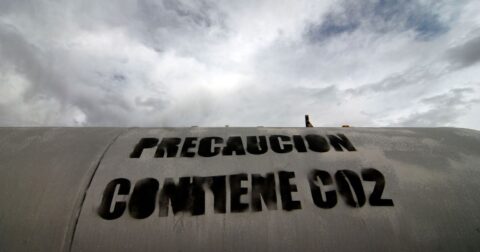Feature
The Meat Industry’s Hidden Link to Wildfires
Climate•6 min read
Reported
Gassing America’s pigs with carbon dioxide could be the emissions equivalent of an extra 6,500 cars on the road every year. And it should be on camera.


Words by Sophie Kevany
The pork industry has spent the past two decades arguing over the best method for slaughtering pigs. While stunning with electrical tongs was once the gold standard, more recently, factory farms have shifted to carbon dioxide gas. Slaughterhouses who favor the move say it reduces human-to-pig contact and may boost meat quality, although research on this is unclear.
If you’re a pig, gassing does not appear to be much of an improvement. Animal welfare groups point to undercover videos where pigs display signs of pain and panic. But there may be another reason for concern too — slaughtering millions of animals per year with carbon dioxide could be pumping thousands of metric tons of emissions into the atmosphere.
Each year, the U.S. pork industry slaughters about 130 million pigs to make ground pork, bacon and chops. An estimated 90 percent are killed using CO2 gas, according to the Animal Welfare Institute — that’s almost 120 million pigs in total — and gassing them with carbon dioxide adds up.
According to industry calculations, each pig requires between 200 and 300 grams of carbon dioxide gas for stunning — around half a pound or so — and potentially even more for slaughter. By rough estimates then, the industry is using 30 thousand metric tons of CO2 to stun or kill 120 million pigs each year, in the U.S. alone. That’s the equivalent of what 6,500 cars pump out each year, at least based on EPA estimates.
An important caveat — it’s possible that the gas used for slaughter is sourced from an industry that already accounts for its emissions. Edgar Manzanilla, a pig researcher with Ireland’s agri-advisory service, points out that if the carbon dioxide used in stunning was “a by-product of, say, the fertilizer industry,” it would mean that the additional gas doesn’t actually drive up the climate cost of pork.
“In Sweden, most of the commercial CO2 available is a by-product from a large ethanol factory,” says Erik Sindhöj, an agricultural engineer and author of a 2021 review of potential alternatives to CO2 for pig stunning. “So it is actually green CO2 or neutral since the source is crops grown within a year,” he says. “Ethanol and alcohol fermentation is a large industry in the U.S., so this could be a potential source for a lot of the CO2 used there too.”
Of course, ethanol production itself isn’t exactly green, according to most climate scientists who study the subject. For instance, research published last year found that corn ethanol is likely a bigger contributor to global warming than gasoline.
More than that, we have no idea where the U.S. pork industry sources its CO2 from anyway. Leading gas chamber manufacturers, Marel and Frontmatec, did not respond to calls or emails from Sentient Media, and there was no reply from the National Pork Producers Council or the Pork Information Gateway.
And consider this — the land used to grow corn and other animal feed crops might be put to better use anyway. A 2018 assessment found that most emissions calculations “systematically underestimate the opportunity of land to store carbon if it is not used for agriculture.” In other words, if some of the farms that grow crops and raise livestock were rewilded, that land would transform from a source of climate pollution to a climate-saving carbon reserve.
Carbon dioxide stunning has plenty of other drawbacks too, especially for the millions of pigs raised and slaughtered in the U.S. each year (not to mention the slaughter of other animals that also fuels pork production).
Stunning with carbon dioxide gas, says Zack Strong, senior staff attorney with the Animal Welfare Institute, “can take a minute or more, and killing can require several minutes. During that time, the gas can cause respiratory distress,” and other symptoms including suffocation and convulsions, he says. This summer, the group launched a petition demanding the USDA require cameras in all gas chambers.
“Undercover video recordings taken in pig slaughter plants in the United States, United Kingdom and Australia reveal the terror and agony that pigs can endure while being gassed with CO2,” Strong adds.
The other concern is that the pigs, once inside the gas chambers, are invisible to workers and inspectors, going against federal law. “Slaughter plant inspectors are unable to observe the pigs while they are being stunned or killed with CO2, because the animals are hidden deep within the machinery of the gas chamber.”
The Federal Meat Inspection Act and Humane Methods of Slaughter Act “require inspectors to conduct an ‘examination and inspection’ of all methods of slaughter and to assess whether those methods are humane,” Strong says. “If inspectors are unable to observe the use of CO2 to stun or kill pigs, there is no way they can examine or inspect the slaughter process, or determine if it is humane, as required by law.”
To improve welfare oversight and comply with the law, Strong says cameras should be installed inside the gas chamber gondolas that hold the pigs. “Cameras would enable inspectors to observe the pigs in real time as they are being gassed and to determine whether or not the procedure is humane.”
There’s yet another option too — eat more plants and fewer pigs. As the EAT Lancet Commission has found, a shift to a more plant-rich diet would be a boost for public health, along with the climate.
Update: The reporting of this story was partially supported by Brighter Green’s Animals and Biodiversity Reporting Fund.